Halifax
Halifax was a market town in West Yorkshire, with a prosperous woollen trade in the days of the ’cottage industries’: weavers of the surrounding countryside worked on looms at home in addition to their agricultural activities; clothiers rode to sell the ’pieces’ of fabric (30 yards) in the cloth hall of the market town. See the website of the buildings, giving its history, and figures of production: in 1700, the national textile production accounted for 70% of exports, of which 20% originated in West Yorkshire; in 1770, the total production had doubled, and West Yorkshire now represented 33% of it.
The earlier cloth hall of Halifax being too small in the early 1770s, the manufacturers opened subscriptions for the construction of a new Piece Hall. Its location was debated, and the present site was chosen due to the influence of a local powerful citizen whose mansion was opposite, after a vote of subcribers by secret ballot, as explained by the Leeds Mercury of 14 May 1774. The subscribers paid 28s 4 d to be owners of one of the 315 rooms, or they could share the subscription.
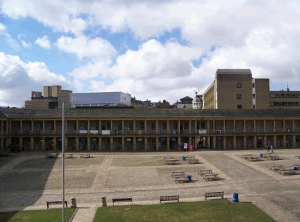
- The Piece Hall
- The Piece Hall, West side with clock (two storeys).
[click on the picture to enlarge it]
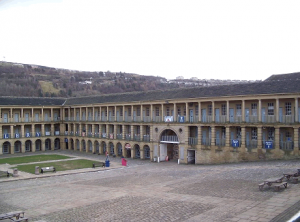
- The Piece Hall
- The Piece Hall, East side (three storeys) and South side (sloping first level)
[click on the picture to enlarge it]
The Piece Hall was built in 1779.It follows the architectural patterns of classical architecture, but the fall of the land made it necessary to have three storeys on the East side and two on the West side, with a sloping first level for the North and South sides; this arcade consists of arches, whereas the two upper storeys follow the classical sequence of ’rustic’ and ’Tuscan’ orders.To maintain classical proportions on such a long structure with narrow tall openings, extra pedestals are needed in the entrance gates (photo below); but the length of the building, in relation to its height, exceeds the classical proportions and is closer to the repetitive industrial architecture, which was in its early stages.
The West side has a clock carrying an ornament of the Golden Fleece. The manufacturers would sell their goods to the merchants from 10 to 12 on Saturdays, and the clock would mark the beginning and end of the sales.
The outside was a blank wall without openings apart from the gates, to protect the merchandise against theft.
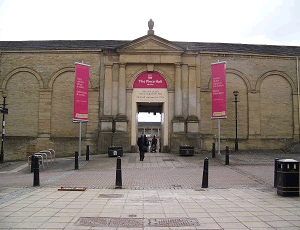
- The North entrance
- [click on the picture to enlarge it]
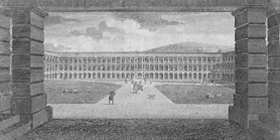
- The Piece Hall
- E.Jacob’s History of the Town and Parish of Halifax, 1789.
[click on the picture to enlarge it]
With the advent of textile mills, cottage industry disappeared, and in the 19th century, the Piece Hall was used for other purposes such as a market. The textile industry moved to the neighbouring town of Leeds, which was on the railway line.
The Piece Hall now contains shops and an information centre from which part of the present information is derived.
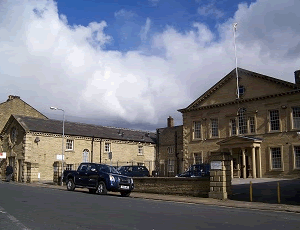
- House of a merchant
- The merchants had fine townhouses, here the house of a merchant with flanking ranges serving as a warehouse (Clare Road).
[click on the picture to enlarge it]
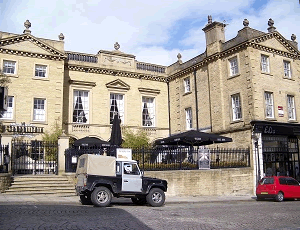
- House of a banker
- The house of a banker which served as a bank (Rawson St). The circulation of money contributed to the prosperity of the area.
[click on the picture to enlarge it]

